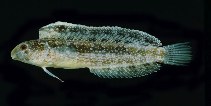| Family: |
Blenniidae (Combtooth blennies), subfamily: Blenniinae |
| Max. size: |
11.5 cm TL (male/unsexed); 7.86 cm SL (female) |
| Environment: |
demersal; marine |
| Distribution: |
Western Indian Ocean: northern Red Sea to the Persian Gulf. Mediterranean Sea: Iskenderun Bay. |
| Diagnosis: |
Dorsal spines (total): 10-11; Dorsal soft rays (total): 17-19; Anal spines: 2-2; Anal soft rays: 17-19 |
| Biology: |
Adults are found in seagrass beds or bottoms with heavy algal growth. Captured at the surface using a hand net (Ref. 26165). Oviparous. Eggs are demersal and adhesive (Ref. 205), and are attached to the substrate via a filamentous, adhesive pad or pedestal (Ref. 94114). Larvae are planktonic, often found in shallow, coastal waters (Ref. 94114). |
| IUCN Red List Status: |
Least Concern (LC); Date assessed: 25 March 2009 Ref. (130435)
|
| Threat to humans: |
harmless |
Source and more info: www.fishbase.org. For personal, classroom, and other internal use only. Not for publication.

